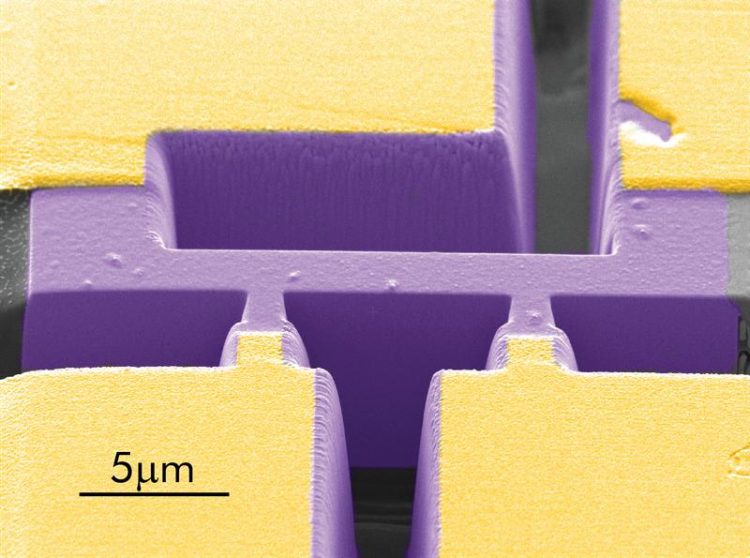Macroscopic quantum interference in an ultra-pure metal

Scanning electron microscope image of a PdCoO2 microstructure to measure c-axis resistivity. © MPI CPfS
As high school students see in experiments with water waves, and we observe and use with light waves in many optical devices, interference is a fundamental property associated with wave-like behavior.
Indeed, Davisson and Germer’s famous observation of interference in experiments with dilute beams of electrons, nearly a century ago, gave key experimental support to the correctness of the then-new quantum theory.
In experiments on solids, however, signatures of quantum interference are rare and hard to observe. This is essentially because there are so many electrons, and so many ways in which they can be ‘scrambled up’, that most interference effects are invisible to experiments that probe distances of more than a few atomic spacings.
One of the themes of research in the Physics of Quantum Materials department is the study of exotic strange layered metals from a structural class with the equally strange name ‘delafossites’, stemming from the famous French crystallographer Gabriel Delafosse.
They are notable because they conduct electricity incredibly well. Indeed, at room temperature one of them, PtCoO2, is the best electrical conductor ever discovered.
As part of our research on the delafossites, we were studying how the conduction perpendicular to the layers depends on magnetic field, in crystals that had been sculpted into particular geometries using a focused ion beam (see Fig. 1).
To our complete surprise, we observed strong oscillations in this conductivity, of a kind that are a signature of some kindsignaling of interference (see Fig. 2).
After a long period of follow-up experiments at this institute and in the new group of our former colleagues Philip Moll and Carsten Putzke, now at EPFL in Lausanne, we collaborated with theorists Takashi Oka and Roderich Moessner in our neighbour institute in Dresden and Ady Stern from the Weizmann Institute in Israel to propose an explanation for what is going on.
Remarkably, it requires a form of quantum coherence over macroscopic distances of up to 50000 atomic lattice spacings. It is only observable because of the remarkable purity of the delafossites, whose origin we established in another set of experiments, also published recently. High quality materials continue to hold a wealth of surprises and delights for those who make and study them!
Carsten.Putzke@epfl.ch
Maja.Bachmann@epfl.ch
Philip.Moll@epfl.ch
Andy.mackenzie@cpfs.mpg.de
Carsten Putzke, Maja D. Bachmann, Philippa McGuinness, Elina Zhakina, Veronika Sunko,Marcin Konczykowski,Takashi Oka, Roderich Moessner, Ady Stern, Markus König, Seunghyun Khim, Andrew P. Mackenzie, Philip J.W. Moll
h/e oscillations in interlayer transport of delafossites
Science Vol 368, Issue 6496, 12 June 2020
DOI 10.1126/science.aay8413
Media Contact
All latest news from the category: Physics and Astronomy
This area deals with the fundamental laws and building blocks of nature and how they interact, the properties and the behavior of matter, and research into space and time and their structures.
innovations-report provides in-depth reports and articles on subjects such as astrophysics, laser technologies, nuclear, quantum, particle and solid-state physics, nanotechnologies, planetary research and findings (Mars, Venus) and developments related to the Hubble Telescope.
Newest articles

Pinpointing hydrogen isotopes in titanium hydride nanofilms
Although it is the smallest and lightest atom, hydrogen can have a big impact by infiltrating other materials and affecting their properties, such as superconductivity and metal-insulator-transitions. Now, researchers from…

A new way of entangling light and sound
For a wide variety of emerging quantum technologies, such as secure quantum communications and quantum computing, quantum entanglement is a prerequisite. Scientists at the Max-Planck-Institute for the Science of Light…

Telescope for NASA’s Roman Mission complete, delivered to Goddard
NASA’s Nancy Grace Roman Space Telescope is one giant step closer to unlocking the mysteries of the universe. The mission has now received its final major delivery: the Optical Telescope…



